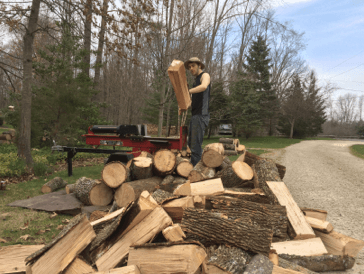You can learn and apply business principles in nearly every situation. This past week, my family and I split wood for three days. It was all about effective teamwork.

Our property is home to dozens of species of trees. All of our Ash trees are either dying or dead, and those closest to our house required removal. We had 27 trees cut down earlier this month. Experts cut down the trees and cut the wood into manageable lengths for firewood. We then moved, split, moved again and stacked the wood.
It was a team effort.
 As I observed the experts work, it occurred to me that how they went about their work was crucial to the excellent job they did for us.
As I observed the experts work, it occurred to me that how they went about their work was crucial to the excellent job they did for us.
Each morning, they arrived at the same time, discussed the plan for tree removal, organized all the tools needed for the job, worked efficiently as a team and cleaned up as they cut the dead trees down. Their method of work happens to be similar to how we go about projects as a family.
When the experts finished their work, our family team moved in to split and stack the wood for future use. Our two boys, our daughter, my sister-in-law and her son all pitched in. It was exhausting work and exhilarating teamwork.
10 Practices to Forge Remarkably Effective Teams
You can apply these in your business and on your next big project.
-
-
- Plan. Knowledgeable teams understand the project and individual roles in-depth before work begins. Take time to discuss the overall project goals in detail and to make sure every team member knows what the job requires.
 Identify the Critical Path. Focused teams know what is important and what is unimportant. When you know the key tasks for project completion, you can meet the needs of that path. For instance, our critical path is keeping the splitter supplied with wood. We focus on keeping the unsplit wood supply within easy reach of the splitter operator. The result is he or she minimizes downtime between each log, which means the split wood supply flows consistently for stacking.
Identify the Critical Path. Focused teams know what is important and what is unimportant. When you know the key tasks for project completion, you can meet the needs of that path. For instance, our critical path is keeping the splitter supplied with wood. We focus on keeping the unsplit wood supply within easy reach of the splitter operator. The result is he or she minimizes downtime between each log, which means the split wood supply flows consistently for stacking.- Seek Input. Adaptive teams gain strength through each members' contribution. The best teams are collaborative, with a steady flow of ideas offered and discussed that improve the work. Ken Blanchard is known for saying “None of us is as smart as all of us.” Our “splitting crew” frequently discusses how to be most efficient.
- Communicate. Capable teams communicate effectively, and communication is more than just verbal. Our splitting team uses hand signals and body language enabling us to communicate through the noise of the machinery. This same concept works in an office environment. For instance, recognizing body language and the tone of voice of colleagues and clients is immensely helpful. The conversation is richer, and you can detect when the discussion does not reflect the underlying emotions.
- Anticipate. Strong teams anticipate what members need and will act before the need hinders the work. In our case, this means recognizing in advance when refueling is necessary, or when our team needs a break.
- Cooperate. Extraordinary teams work together to complete tasks. Andrew Carnegie said “Teamwork is the ability to work together toward a shared vision. Capacity to direct individual accomplishments toward organizational objectives. It is the fuel that allows common people to attain uncommon results.” Each team member focuses on their job and is simultaneously aware of what the rest of the team is doing in the context of our overall goals.
- Defer. Versatile teams adapt to the working style of individual members. When splitting, we each handle and split the pieces differently. We have learned not to tell the person doing the work how it should be done, but rather to assist them in the way they do it. Everybody ends up happier, and we constantly learn new ways of doing a job through understanding what and how someone else does their job.
- Assess. Learning teams analyze their processes and output. We frequently discuss how we can improve efficiency and speed while working. Solid teams regularly evaluate their work, how to accomplish it well and how to incorporate improvements.
- Recognize. Satisfied teams know the contributions of every member. When the job wraps up, make sure you recognize the contributions of each team member. “Thank You” goes a long way. Whenever you can, go the extra mile and creatively reward your team for excellent work.
- Celebrate. Dedicated teams proclaim their successes. Make sure you celebrate each member's great work. Celebrate not just within the team, but across your organization. Show off how fantastic your team is to non-team members, executives and customers to build a great culture of trust and commitment.
-
Tangible and Intangible Results

“None of us
is as smart
as all of us”
The intangible result is that we function as a team within our family and our kids know what makes a team effective. That knowledge will pay dividends throughout their careers.
Are you leading teams that emphasize these practices?





